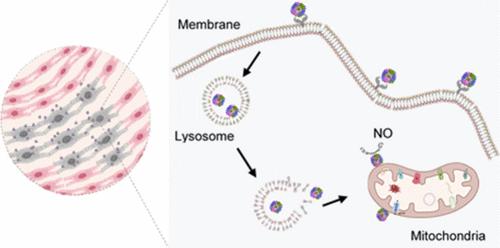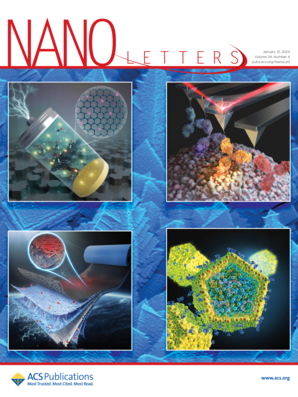基因工程线粒体靶向纳米酶减轻心肌缺血-再灌注损伤的合理设计
IF 9.6
1区 材料科学
Q1 CHEMISTRY, MULTIDISCIPLINARY
引用次数: 0
摘要
线粒体靶向纳米酶的开发对心肌缺血再灌注(IR)损伤的治疗具有重要的前景,但面临着重大的生物学障碍。为了克服这些障碍,我们在此利用基因工程铁蛋白纳米笼(即imFTn)开发线粒体靶向纳米酶,该纳米酶由三个铁蛋白亚基组装模块组成:ir损伤心肌细胞靶向模块、溶酶体逃逸模块和线粒体靶向模块。利用imFTn作为纳米酶平台,我们开发了能够有效催化l-Arg底物产生NO的纳米酶。imFTn-Ru具有no生成活性,减少线粒体活性氧生成,抑制线粒体通透性过渡孔打开,增强线粒体膜电位。此外,在体外和体内模型中,imFTn-Ru通过特异性靶向心肌ir损伤组织,促进其在线粒体中的积累,并保护线粒体免受心肌ir诱导的损伤,从而提供协同作用。本研究强调了设计针对特定亚细胞细胞器的纳米酶治疗IR损伤的合理方法。本文章由计算机程序翻译,如有差异,请以英文原文为准。

Rational Design of Genetically Engineered Mitochondrial-Targeting Nanozymes for Alleviating Myocardial Ischemic-Reperfusion Injury
The development of mitochondria-targeting nanozymes holds significant promise for treating myocardial ischemia-reperfusion (IR) injury but faces significant biological barriers. To overcome these obstacles, we herein utilized genetically engineered ferritin nanocages (i.e., imFTn) to develop mitochondria-targeting nanozymes consisting of three ferritin subunit assembly modules: an IR-injured cardiomyocyte-targeting module, a lysosome-escaping module, and a mitochondria-targeting module. Using imFTn as a nanozyme platform, we developed nanozymes capable of efficiently catalyzing the l-Arg substrate to produce NO. The imFTn-Ru exhibits NO-generating activities, reduces mitochondrial reactive oxygen species generation, inhibits mitochondrial permeability transition pore opening, and enhances mitochondrial membrane potential. Furthermore, imFTn-Ru provides synergistic effects by specifically targeting myocardial IR-injured tissues, facilitating their accumulation in mitochondria, and protecting mitochondria against myocardial IR-induced injury in both in vitro and in vivo models. This study underscores a rational approach to designing nanozymes for targeting specific subcellular organelles in the treatment of IR injury.
求助全文
通过发布文献求助,成功后即可免费获取论文全文。
去求助
来源期刊

Nano Letters
工程技术-材料科学:综合
CiteScore
16.80
自引率
2.80%
发文量
1182
审稿时长
1.4 months
期刊介绍:
Nano Letters serves as a dynamic platform for promptly disseminating original results in fundamental, applied, and emerging research across all facets of nanoscience and nanotechnology. A pivotal criterion for inclusion within Nano Letters is the convergence of at least two different areas or disciplines, ensuring a rich interdisciplinary scope. The journal is dedicated to fostering exploration in diverse areas, including:
- Experimental and theoretical findings on physical, chemical, and biological phenomena at the nanoscale
- Synthesis, characterization, and processing of organic, inorganic, polymer, and hybrid nanomaterials through physical, chemical, and biological methodologies
- Modeling and simulation of synthetic, assembly, and interaction processes
- Realization of integrated nanostructures and nano-engineered devices exhibiting advanced performance
- Applications of nanoscale materials in living and environmental systems
Nano Letters is committed to advancing and showcasing groundbreaking research that intersects various domains, fostering innovation and collaboration in the ever-evolving field of nanoscience and nanotechnology.
 求助内容:
求助内容: 应助结果提醒方式:
应助结果提醒方式:


